Fact Families are fundamental math tools that illustrate the relationships between numbers, helping to build a strong foundation in arithmetic. Think of fact families as groups of related math facts using the same set of three numbers. Just like understanding family relationships in life, grasping fact families in math unlocks a deeper understanding of how numbers interact through addition, subtraction, multiplication, and division.
Recommended Games
[ 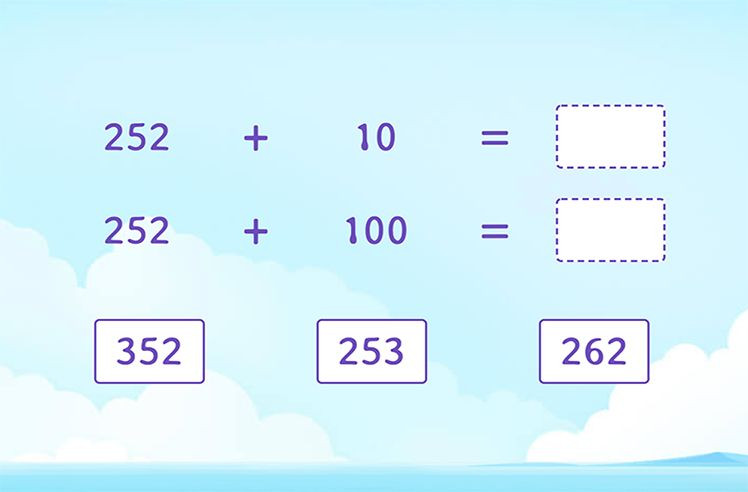 10 and 100 More than the Same Number Game
10 and 100 More than the Same Number Game
10 and 100 More than the Same Number Game
Play
](https://www.splashlearn.com/s/math-games/10-and-100-more-than-the-same-number)
[ 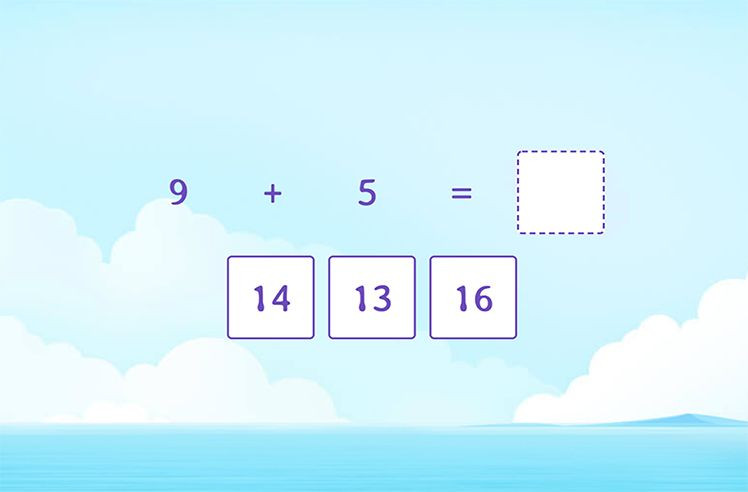 Add 1-Digit Numbers Game
Add 1-Digit Numbers Game
Add 1-Digit Numbers Game
Play
](https://www.splashlearn.com/s/math-games/add-1-digit-numbers)
[  Add 10 to a 3-Digit Number Game
Add 10 to a 3-Digit Number Game
Add 10 to a 3-Digit Number Game
Play
](https://www.splashlearn.com/s/math-games/add-10-to-a-3-digit-number)
[ 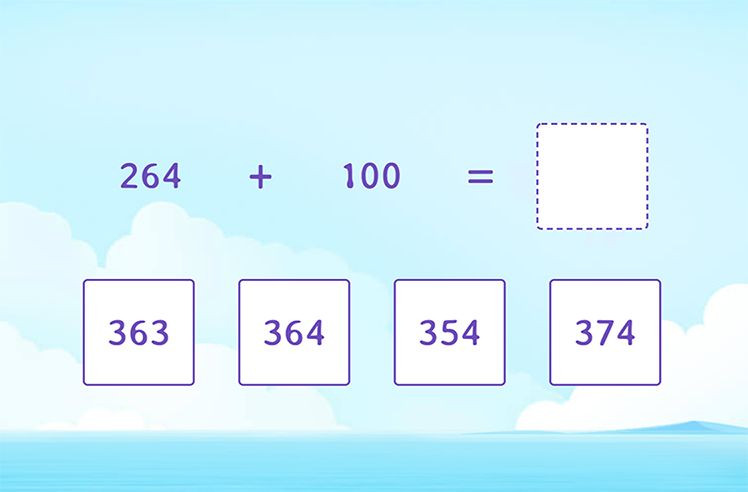 Add 100 to a 3-Digit Number Game
Add 100 to a 3-Digit Number Game
Add 100 to a 3-Digit Number Game
Play
](https://www.splashlearn.com/s/math-games/add-100-to-a-3-digit-number)
[ 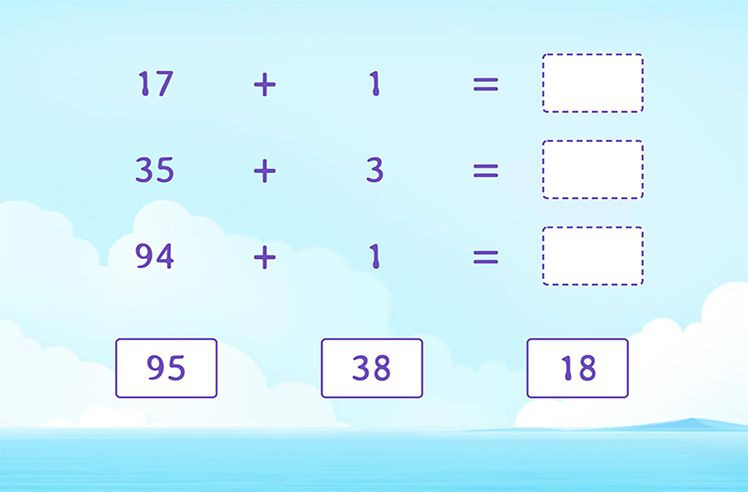 Add 2-Digit and 1-Digit Numbers Game
Add 2-Digit and 1-Digit Numbers Game
Add 2-Digit and 1-Digit Numbers Game
Play
](https://www.splashlearn.com/s/math-games/add-2-digit-and-1-digit-numbers)
[ 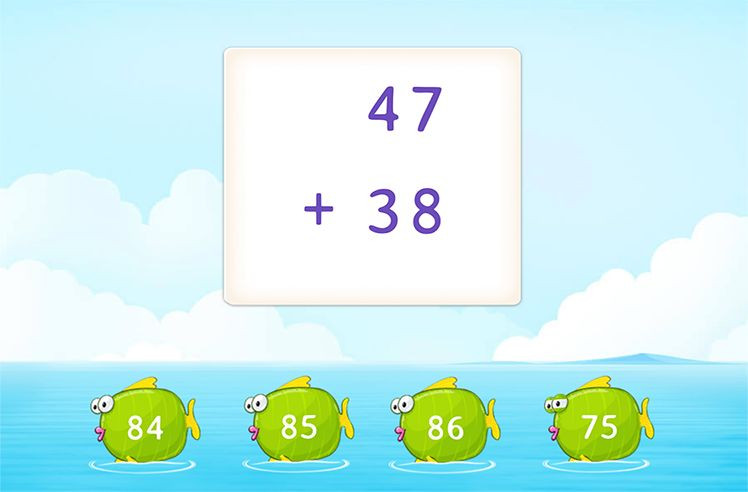 Add 2-Digit Numbers By Regrouping Game
Add 2-Digit Numbers By Regrouping Game
Add 2-Digit Numbers By Regrouping Game
Play
](https://www.splashlearn.com/s/math-games/add-2-digit-numbers-by-regrouping)
[ 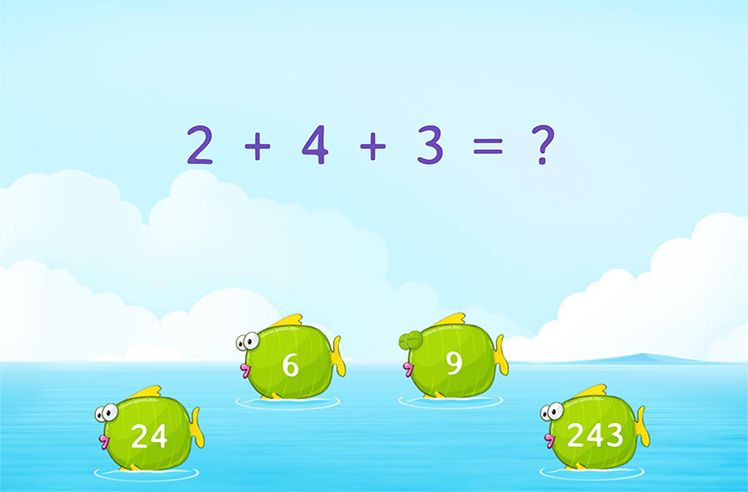 Add 3 Numbers Game
Add 3 Numbers Game
Add 3 Numbers Game
Play
](https://www.splashlearn.com/s/math-games/add-3-numbers)
[ 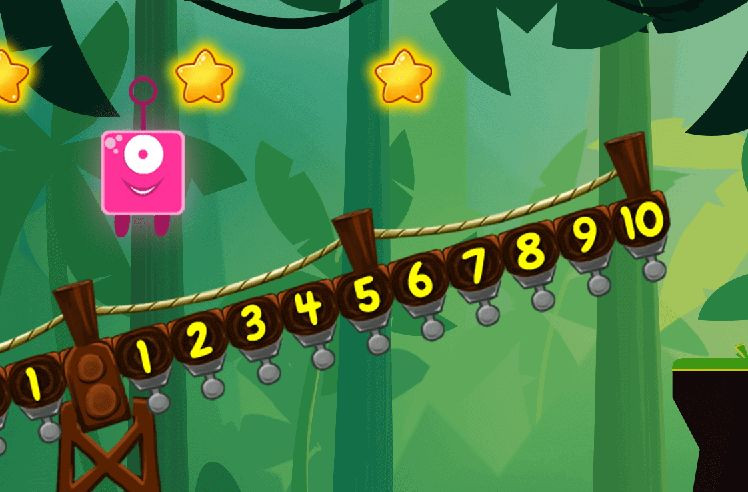 Add 3 Numbers in Any Order Game
Add 3 Numbers in Any Order Game
Add 3 Numbers in Any Order Game
Play
](https://www.splashlearn.com/s/math-games/add-3-numbers-in-any-order)
[ 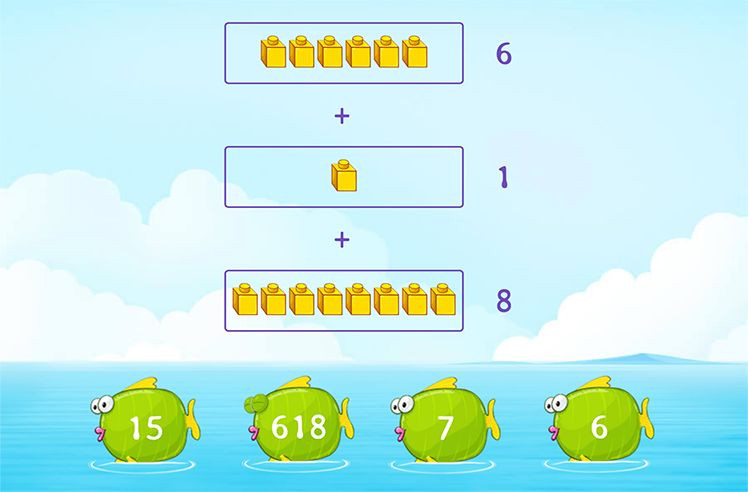 Add 3 Numbers Using Groups of Objects Game
Add 3 Numbers Using Groups of Objects Game
Add 3 Numbers Using Groups of Objects Game
Play
](https://www.splashlearn.com/s/math-games/add-3-numbers-using-groups-of-objects)
[ 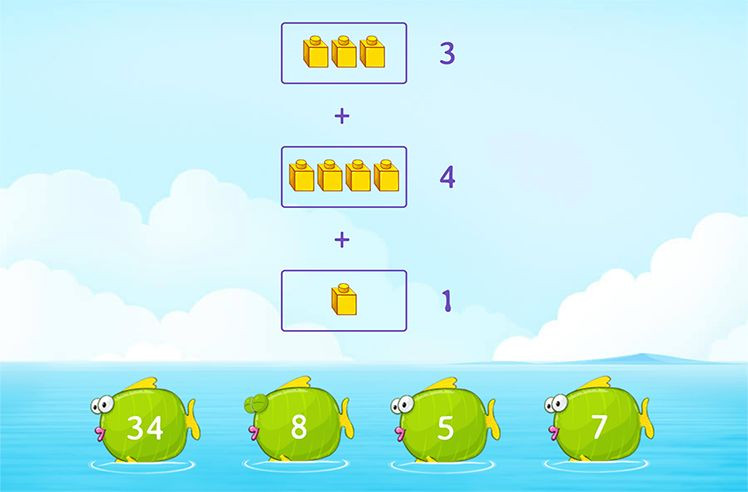 Add 3 Numbers using Model Game
Add 3 Numbers using Model Game
Add 3 Numbers using Model Game
Play
](https://www.splashlearn.com/s/math-games/add-3-numbers-using-model)
More Games
Understanding the Fact Family Definition
A fact family, also known as a number family, is a set of related math equations that use the same three numbers. These equations demonstrate the inverse relationships between addition and subtraction, as well as multiplication and division. Typically, a fact family will include two addition and two subtraction equations, or two multiplication and two division equations, all derived from the same three numbers.
Fact families are essential tools for young learners as they:
- Build Number Sense: They help children recognize the relationships between numbers.
- Master Basic Operations: They reinforce the connection between addition and subtraction, and multiplication and division.
- Improve Math Fluency: By understanding fact families, children can quickly recall related math facts, improving their speed and accuracy in calculations.
- Solve Problems More Effectively: Fact families provide a framework for understanding and solving various arithmetic problems.
Recommended Worksheets
[ 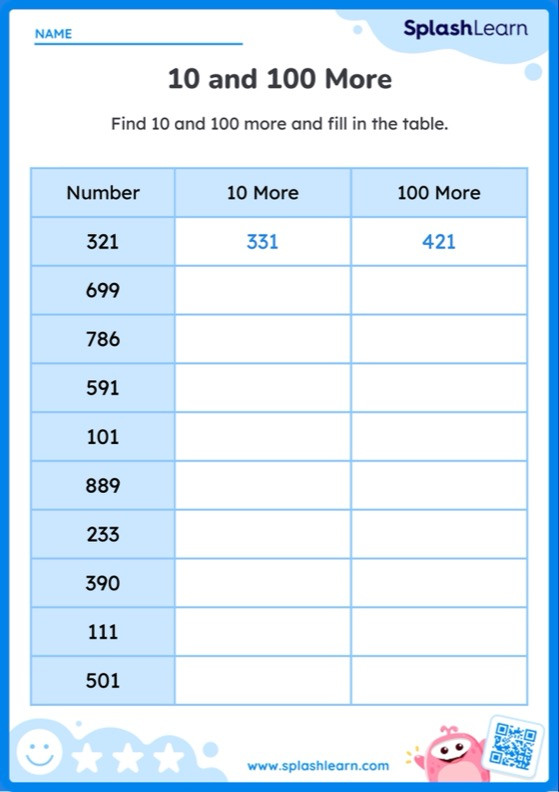 Worksheet on 10 and 100 More than a 3-digit Number
Worksheet on 10 and 100 More than a 3-digit Number
](https://www.splashlearn.com/s/math-worksheets/10-and-100-more-than-a-3-digit-number)
[ 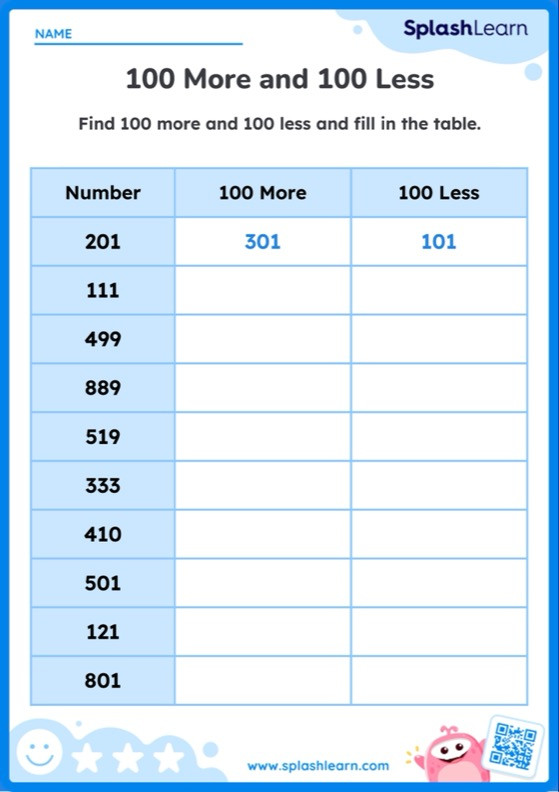 Worksheet on 100 More and 100 Less than a 3-digit Number
Worksheet on 100 More and 100 Less than a 3-digit Number
](https://www.splashlearn.com/s/math-worksheets/100-more-and-100-less-than-a-3-digit-number)
[ 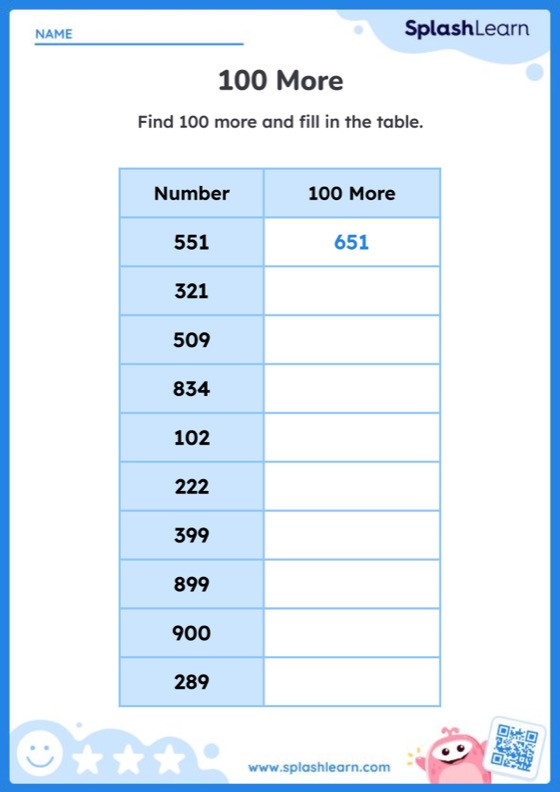 Worksheet on 100 More than a 3-digit Number
Worksheet on 100 More than a 3-digit Number
](https://www.splashlearn.com/s/math-worksheets/100-more-than-a-3-digit-number)
[  Worksheet on Add & Subtract Ones & 2-Digit Numbers
Worksheet on Add & Subtract Ones & 2-Digit Numbers
](https://www.splashlearn.com/s/math-worksheets/add-subtract-ones-2-digit-numbers)
[ 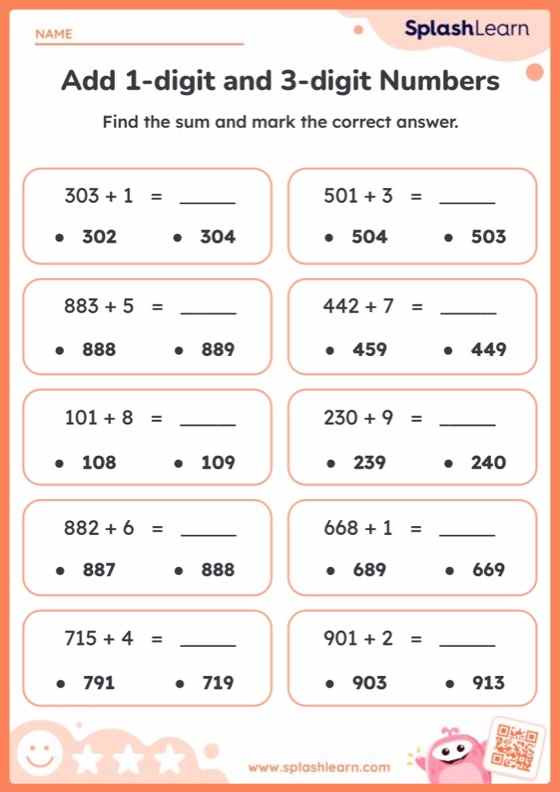 Worksheet on Add 1 Digit and 3 Digit Numbers and Find the Sum
Worksheet on Add 1 Digit and 3 Digit Numbers and Find the Sum
](https://www.splashlearn.com/s/math-worksheets/add-1-digit-and-3-digit-numbers-and-find-the-sum)
[ 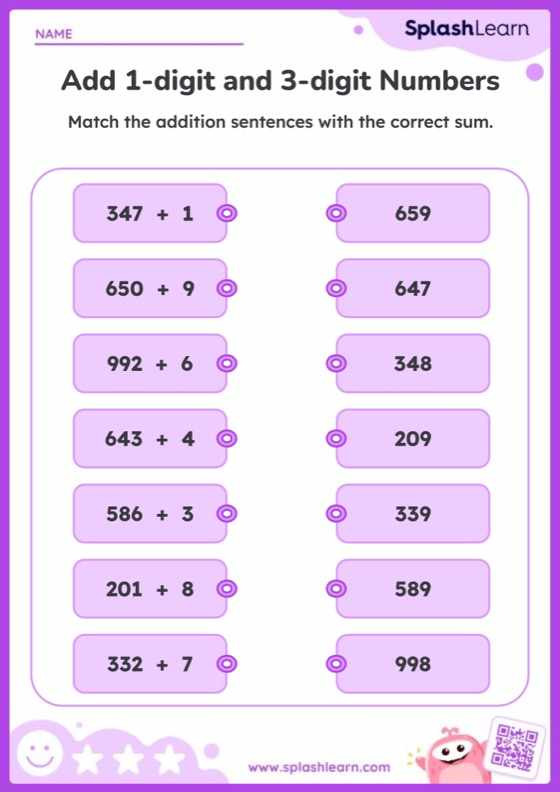 Worksheet on Add 1 Digit and 3 Digit Numbers and Match the Sum
Worksheet on Add 1 Digit and 3 Digit Numbers and Match the Sum
](https://www.splashlearn.com/s/math-worksheets/add-1-digit-and-3-digit-numbers-and-match-the-sum)
[ 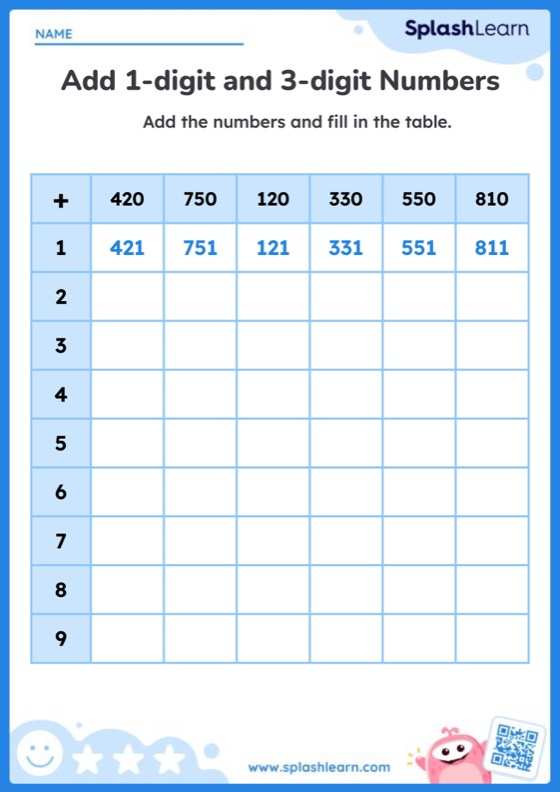 Worksheet on Add 1 Digit and 3 Digit Numbers Using Addition Tables
Worksheet on Add 1 Digit and 3 Digit Numbers Using Addition Tables
](https://www.splashlearn.com/s/math-worksheets/add-1-digit-and-3-digit-numbers-using-addition-tables)
[ 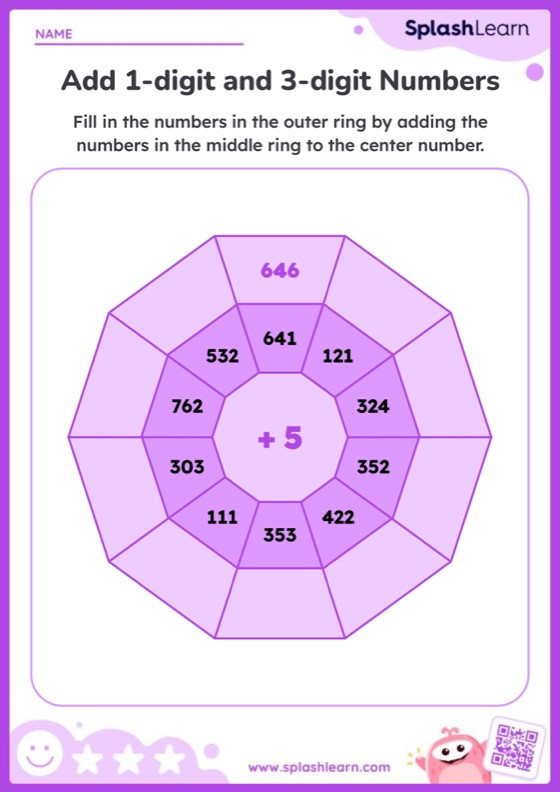 Worksheet on Add 1 Digit and 3 Digit Numbers Using Addition Wheel
Worksheet on Add 1 Digit and 3 Digit Numbers Using Addition Wheel
](https://www.splashlearn.com/s/math-worksheets/add-1-digit-and-3-digit-numbers-using-addition-wheel)
[ 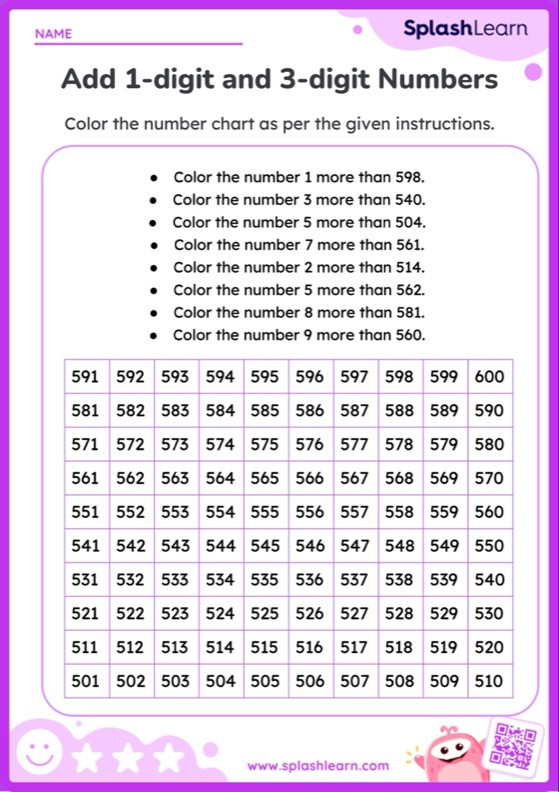 Worksheet on Add 1 Digit and 3 Digit Numbers Using Number Charts
Worksheet on Add 1 Digit and 3 Digit Numbers Using Number Charts
](https://www.splashlearn.com/s/math-worksheets/add-1-digit-and-3-digit-numbers-using-number-charts)
[ 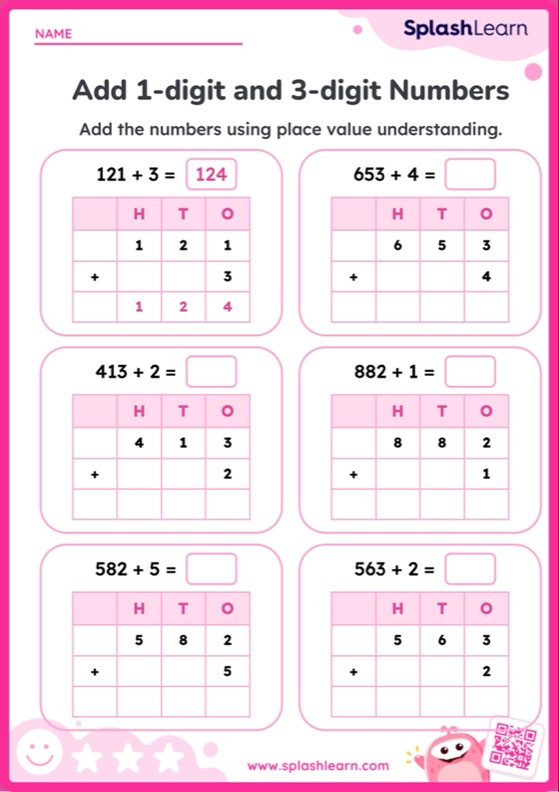 Worksheet on Add 1 Digit and 3 Digit Numbers Using Place Value
Worksheet on Add 1 Digit and 3 Digit Numbers Using Place Value
](https://www.splashlearn.com/s/math-worksheets/add-1-digit-and-3-digit-numbers-using-place-value)
More Worksheets
The Fact Family Triangle: A Visual Representation
One of the most helpful ways to visualize fact families is through the fact family triangle. This triangle diagram neatly organizes the three numbers of a fact family and the operations that connect them.
In a fact family triangle:
- The three numbers that form the fact family are placed at each vertex (corner) of the triangle.
- The operation symbol (+, -, ×, ÷) is usually written inside the triangle.
- For addition and subtraction fact families, the largest number (the sum) is typically placed at the top vertex, while the two smaller numbers (addends) are at the bottom vertices.
Let’s consider an example using the numbers 2, 5, and 7. In their fact family triangle, 7 (the sum) would be at the top, and 2 and 5 would be at the bottom corners.
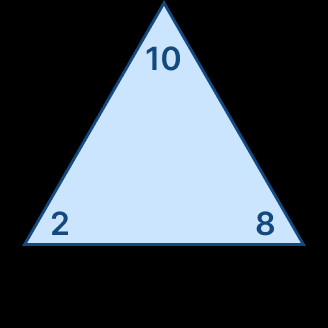 Fact family triangle showing numbers 2, 5, and 7 for addition and subtraction
Fact family triangle showing numbers 2, 5, and 7 for addition and subtraction
Fact family triangles make it easy to see the relationships and quickly derive all four related math facts. Let’s explore addition/subtraction and multiplication/division fact families in more detail.
Addition and Subtraction Fact Families: Parts and Whole
Addition and subtraction fact families are built upon the relationship between parts and a whole. In addition, we combine parts to find the whole (sum). Subtraction is the inverse, where we take away a part from the whole to find the remaining part (difference).
Consider a scenario with 12 crayons in total. If 8 are yellow and 4 are red, we can represent this as a fact family using the numbers 4, 8, and 12. Here are the four related addition and subtraction facts:
- Adding the parts: $4 + 8 = 12$
- Changing the order of addends: $8 + 4 = 12$ (Commutative Property of Addition)
- Subtracting one part from the whole: $12 – 8 = 4$
- Subtracting the other part from the whole: $12 – 4 = 8$
This fact family clearly demonstrates that addition and subtraction are inverse operations. The fact family triangle for 4, 8, and 12 visually reinforces these connections.
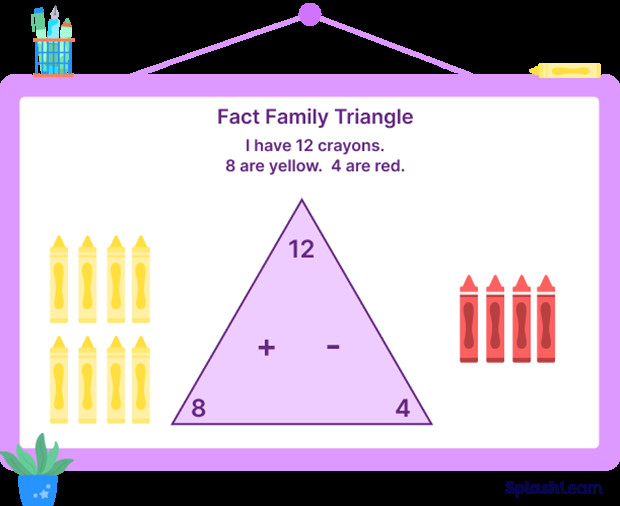 Addition and subtraction fact family triangle for numbers 4, 8, and 12
Addition and subtraction fact family triangle for numbers 4, 8, and 12
Another example using numbers 9, 4, and 5: Here, 4 and 5 are the parts, and 9 is the whole. The fact family equations are:
- $4 + 5 = 9$
- $5 + 4 = 9$
- $9 – 4 = 5$
- $9 – 5 = 4$
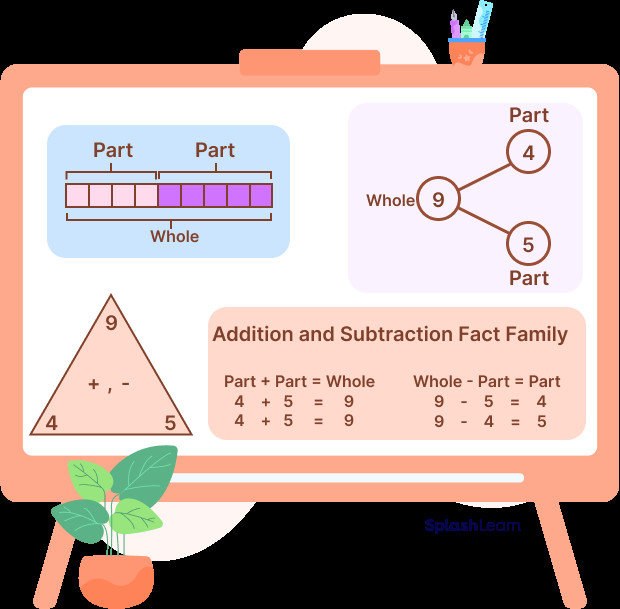 Addition and subtraction fact family equations for numbers 4, 5, and 9 showing all four equations
Addition and subtraction fact family equations for numbers 4, 5, and 9 showing all four equations
Multiplication and Division Fact Families: Factors and Product
Multiplication and division fact families work similarly, but they are based on the relationship between factors and a product. In multiplication, we multiply factors to get a product. Division is the inverse, where we divide the product by one factor to find the other factor (quotient).
Imagine an art class with 8 students seated at 4 tables, with 2 students at each table. We can use the numbers 2, 4, and 8 to create a multiplication and division fact family. The four relationships are:
- Multiplying the factors: $4 × 2 = 8$
- Changing the order of factors: $2 × 4 = 8$ (Commutative Property of Multiplication)
- Dividing the product by one factor: $8 ÷ 4 = 2$
- Dividing the product by the other factor: $8 ÷ 2 = 4$
This fact family highlights the inverse relationship between multiplication and division.
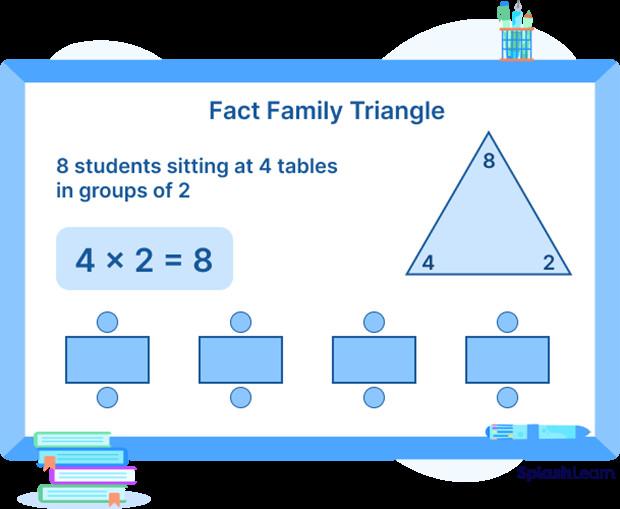 Multiplication and division fact family example with 2, 4, and 8 in a triangle
Multiplication and division fact family example with 2, 4, and 8 in a triangle
Let’s take another example with numbers 3, 4, and 12. Here, 3 and 4 are factors, and 12 is the product. The equations are:
- $3 × 4 = 12$
- $4 × 3 = 12$
- $12 ÷ 3 = 4$
- $12 ÷ 4 = 3$
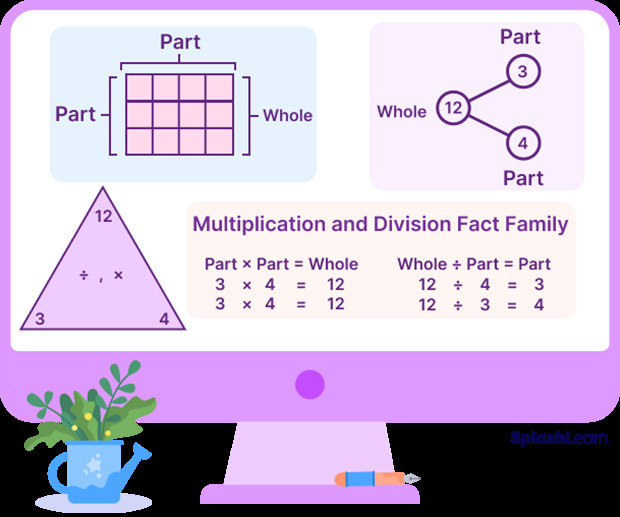 Multiplication and division fact family equations for 3, 4, and 12 showing all four equations
Multiplication and division fact family equations for 3, 4, and 12 showing all four equations
Fun Fact: Inverse Operations in Action!
Fact families beautifully illustrate the concept of inverse operations. Addition is the inverse of subtraction, and multiplication is the inverse of division. Understanding this inverse relationship is a crucial step in developing mathematical thinking and problem-solving skills.
Math Fact Rap (Get Ready to Learn!)
Three numbers, a family so neat,
Multiply and divide, can’t be beat!
Add or subtract, it’s plain to see,
A fact family, for you and for me!
Conclusion: Building Blocks for Math Success
Fact families are more than just memorizing math facts; they are about understanding the interconnectedness of numbers and operations. By mastering fact families, children develop a flexible and robust understanding of arithmetic. This foundational knowledge is essential for tackling more complex math problems in the future and fosters confidence in their mathematical abilities. Learning fact families is a key step in building strong problem-solving and analytical thinking skills that will benefit students throughout their math journey.
Solved Examples: Putting Fact Families into Practice
Let’s work through some examples to solidify our understanding of fact families.
1. Identify the addition and subtraction equations for the given fact family triangle.
 Fact family triangle with numbers 2, 8, and 10
Fact family triangle with numbers 2, 8, and 10
Solution: The numbers in this fact family are 2, 8, and 10.
Addition Equations:
- $8 + 2 = 10$
- $2 + 8 = 10$
Subtraction Equations:
- $10 – 2 = 8$
- $10 – 8 = 2$
2. Determine the multiplication and division equations for the following fact family triangle.
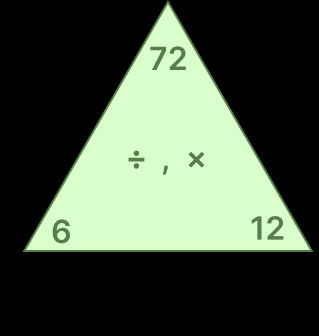 Fact family triangle with numbers 6, 12, and 72
Fact family triangle with numbers 6, 12, and 72
Solution: The numbers are 6, 12, and 72.
Multiplication Equations:
- $6 × 12 = 72$
- $12 × 6 = 72$
Division Equations:
- $72 ÷ 6 = 12$
- $72 ÷ 12 = 6$
3. Create a fact family triangle for the numbers 4, 5, and 20, and write out the equations.
Solution:
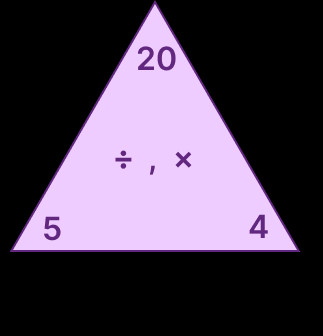 Fact family triangle with numbers 4, 5, and 20
Fact family triangle with numbers 4, 5, and 20
Multiplication Equations:
- $4 × 5 = 20$
- $5 × 4 = 20$
Division Equations:
- $20 ÷ 4 = 5$
- $20 ÷ 5 = 4$
4. Complete the fact family triangle and equations for the numbers 3, 6, and 9.
Solution:
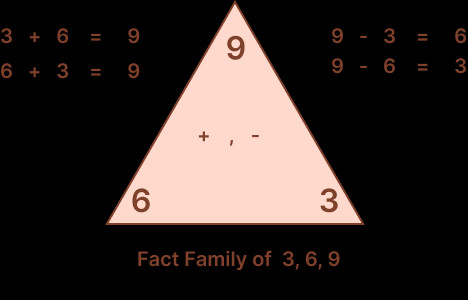 Fact family triangle with numbers 3, 6, and 9
Fact family triangle with numbers 3, 6, and 9
Equations:
- $3 + 6 = 9$
- $6 + 3 = 9$
- $9 – 3 = 6$
- $9 – 6 = 3$

